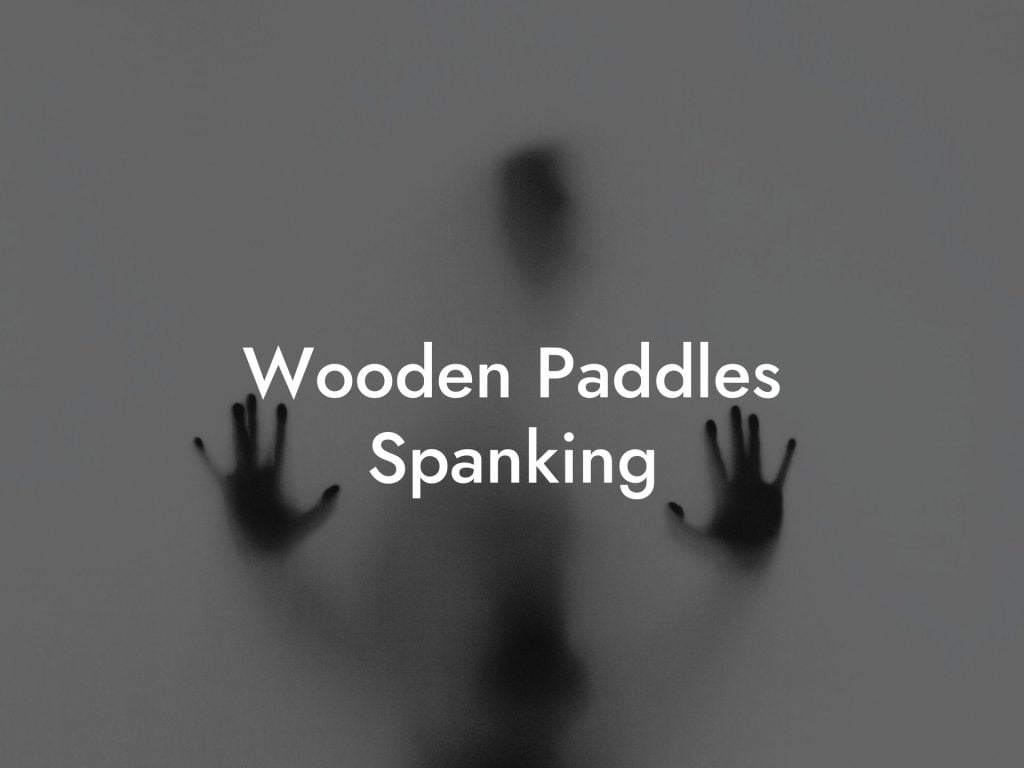Wooden paddles have been used for centuries as a tool for discipline in various contexts. Whether you're indulging in a playful spanking session or exploring the world of BDSM, a well-crafted wooden paddle can add an exciting element to your experiences. In this article, we will dive into the world of wooden paddles, exploring their benefits, techniques, and realistic examples to enhance your disciplinary endeavors.
Wooden Paddle for Discipline Table of Contents
Benefits of Using a Wooden Paddle:
- Durability and Authenticity: Unlike synthetic materials, a wooden paddle offers durability and a natural feel, providing a more genuine experience.
- Versatility: Wooden paddles come in various shapes, sizes, and designs, allowing individuals to customize their disciplinary experiences.
- Sensation and Control: The firm yet flexible nature of a wooden paddle offers both a satisfying impact and precise control during play.
Choosing the Right Wooden Paddle:
1. Size and Thickness: Consider your level of experience and desired intensity when selecting the size and thickness of a paddle. Thicker paddles provide a more intense impact, while thinner ones offer a gentler experience.
2. Material: Explore different types of wood, such as oak, maple, or cherry, each providing unique sensations and aesthetics.
3. Handle: Opt for a paddle with a comfortable and secure handle that allows for a confident grip during use.
Techniques for Effective Discipline:
1. Communication and Consent: Establish clear boundaries and obtain enthusiastic consent from all parties involved to ensure a safe and consensual experience.
2. Warm-Up: Begin with a gentle warm-up, gradually increasing the intensity of the strikes to build anticipation and arousal.
3. Target Areas: Focus on fleshy areas such as the buttocks or upper thighs, avoiding sensitive areas like the lower back or kidneys.
4. Rhythm and Timing: Develop a consistent rhythm and timing for each strike, ensuring both partners can synchronize and maximize pleasure.
5. Aftercare: After the session, offer comfort, reassurance, and physical care to the recipient, creating a nurturing environment for emotional bonding.
Wooden Paddle for Discipline Example:
Imagine a scenario where a couple decides to explore the world of disciplinary spankings. They begin by discussing and setting clear boundaries, expressing their desires and establishing a safe word for immediate stoppage. The dominant partner gently warms up their submissive partner's buttocks, gradually increasing the intensity with a skillfully crafted wooden paddle. Each strike delivers a powerful but manageable sensation, leaving the submissive partner yearning for more. After the session, they engage in aftercare, providing soothing lotions and emotional support.
Frequently Asked Questions
What is impact play in the context of BDSM?
Impact play refers to a sexual practice within the BDSM spectrum where one partner strikes the other for the purpose of pleasure and erotic stimulation. This can include tools like floggers, paddles, whips, or canes, as well as using hands for spanking. The sensation can vary wildly, from gentle tapping to more intense strikes, and is often balanced with the masochistic pleasures of the receiving partner.
What are floggers, and how are they used?
Floggers are one of the most common tools used in impact play. They consist of a handle with multiple strands or 'tails' hanging from it. Floggers can be made from various materials such as leather, suede, or rope. They are used by swinging the tails against the skin, creating a sensation that can range from soft and thuddy to sharp and stingy, depending on the material and force of use.
What distinguishes a paddle from other impact tools?
A paddle is an impact tool that typically has a broad, flat surface. It is generally made from materials such as wood, leather, or plastic, and delivers a more diffuse impact than whips or canes. The sensation from a paddle is often described as a "thud" and can cover a larger area of the body with each strike.
Can you explain BDSM power dynamics?
BDSM power dynamics involve a consensual and negotiated exchange of power between individuals. These roles are often categorized as dominant (the person who takes control in the dynamic) and submissive (the person who relinquishes control). Power dynamics can be nuanced and may include other roles such as 'Master/Slave', 'Owner/Property', 'Daddy/Mommy/Little', and others, all of which can be fluid and play different parts within a scene or relationship.
Why is consent critical in BDSM?
Consent is the bedrock of all BDSM activities. It denotes the agreement between all parties involved regarding what will happen during the scene. Consent must be informed, voluntary, and revocable at any time, ensuring that the play remains safe, sane, and consensual. Without clear consent, an act is not BDSM but rather an abuse of trust and can be illegal.
How is trust developed in a BDSM relationship?
Trust in a BDSM relationship is developed through open communication, honesty, and respect. It involves discussing limits, desires, and experiences before engaging in play, and continuously checking in with each other. Safety and agreed upon terms help build a solid foundation of trust that can lead to more fulfilling and adventurous scenes.
What safety precautions should be taken during impact play?
Safety during impact play involves setting clear limits, using safe words, and being aware of the physical and emotional state of both partners. Avoid hitting areas with vital organs or where the bone is close to the skin. Aftercare is also essential, providing time for participants to recover and discuss the experience. Knowledge about the tools and their correct use is also crucial for safe play.
What are safe words, and why are they important?
Safe words are predetermined words or phrases used during BDSM play that signal when someone wants to slow down, pause, or stop the scene. They are critical for maintaining safety and ensuring that all activities remain consensual. It allows participants to communicate their comfort levels and boundaries clearly, which is especially important during intense scenes or where normal verbal cues might be part of the play.
How do you negotiate a scene involving impact play?
Negotiating a scene involving impact play entails discussing and agreeing on various aspects such as the type of impact tools to be used, the intensity of strikes, limits, safe words, and the duration of the scene. It's crucial to cover any specific desires or fantasies, as well as to address potential risks and how to handle them. Good negotiation ensures that the scene is enjoyable and consensual for all participants.
What is aftercare, and why is it significant?
Aftercare refers to the attention and care given to partners after a BDSM scene, which can be both physical and emotional. It provides comfort and helps return participants to a state of normativity after an intense experience. Aftercare can involve cuddling, debriefing about the scene, treating any marks or soreness, and reaffirming mutual respect and affection. It's significant because it helps prevent subdrop or topspace, conditions where participants might feel a sudden emotional or physical crash after a scene.
How does one approach setting boundaries in BDSM?
Setting boundaries in BDSM involves clear, honest communication about what each person is comfortable with, their hard limits (activities they will not partake in), and soft limits (activities they might be hesitant about). Boundaries should be respected at all times and can be renegotiated as trust and comfort levels change.
What role does communication play in BDSM relationships?
Communication is paramount in BDSM relationships. It entails talking about desires, boundaries, experiences, and concerns. Effective communication before, during, and after scenes ensures that the play is safe, consensual, and fulfilling. It also helps to maintain the relationship's health and the well-being of all participants.
Is it necessary to have a 'BDSM contract'?
A BDSM contract isn't necessary but can be helpful, especially in more formal or long-term power exchange relationships. It outlines the agreed-upon terms, responsibilities, limits, and safe words, providing a clear reference for both parties. Contracts help to prevent misunderstandings and affirm the consensual nature of the relationship.
What is the difference between a scene and a session in BDSM?
A 'scene' typically refers to a single instance of BDSM play, which can be planned or spontaneous, and it often follows a set of negotiated terms and activities. A 'session' might imply a more formal or longer-duration encounter, sometimes used interchangeably with 'scene' but can also indicate a series of scenes or continuous play over time.
How can someone safely explore their limits in BDSM?
Exploring limits in BDSM should be done gradually and with clear communication. Using safe words and regularly checking in with each other helps to maintain safety. It's also wise to research activities beforehand, engage in discussions with more experienced BDSM practitioners and consider attending workshops or demos for practical and safe exploration.
Can impact play be therapeutic?
Some individuals find impact play therapeutic as it can lead to cathartic experiences or stress relief. It could also help individuals to explore power, control, and vulnerability in a controlled and safe environment. However, while impact play can be physically and emotionally intense, it should not be used as a replacement for professional therapy if one is dealing with mental health issues.
Are there any emotional risks associated with BDSM?
Like any intimate or emotionally charged activity, BDSM can carry emotional risks, particularly if practiced without clear communication and boundaries. It may stir up unexpected feelings or responses, and participants might experience 'drop', a feeling of sadness or emptiness following an intense scene. Ensuring proper aftercare and supporting open communication can help mitigate these risks.
Can you participate in BDSM without sex?
Yes, BDSM does not inherently involve sex. Many people engage in BDSM practices for power exchange, pleasure, or pain without incorporating any sexual activities. How one incorporates BDSM into their personal lives is entirely up to them and their consenting partners.
What should you do if something goes wrong during a BDSM scene?
If something goes wrong during a BDSM scene – whether physical injury, emotional distress, or a boundary being crossed – the scene should be paused or stopped immediately using the agreed-upon safe word or signal. Attend to any injuries, provide emotional support, and discuss what happened in a calm and non-judgmental manner. Learning from the incident and adjusting future practices is also important for prevention.
How do beginners get involved in BDSM?
Beginners interested in BDSM should start by educating themselves through books, credible online resources, and conversations with experienced practitioners. Networking with the BDSM community, such as joining forums, attending munches (social gatherings), and going to workshops, can also provide opportunities for learning and support. Start slowly and prioritize safety, consent, and communication in all practices.
Is it normal to have reservations about BDSM?
It is completely normal to have reservations about BDSM. Cultural stigma, personal values, and the way BDSM is portrayed in media can all affect one's perspective. If you're curious but hesitant, take the time to explore what specific aspects give you pause and seek out reliable information. Communicating with understanding partners or community members can also help alleviate concerns.
Now that you have a deeper understanding of the benefits, techniques, and realistic examples of using a wooden paddle for discipline, it's time to embark on your own adventure. Visit Filthy Adult to order your artisan-made wooden paddle, explore our range of guides on BDSM, and indulge in the wide selection of fetish products available in our shop. Don't forget to share this article with your fellow kink enthusiasts and spread the excitement of disciplinary play.













